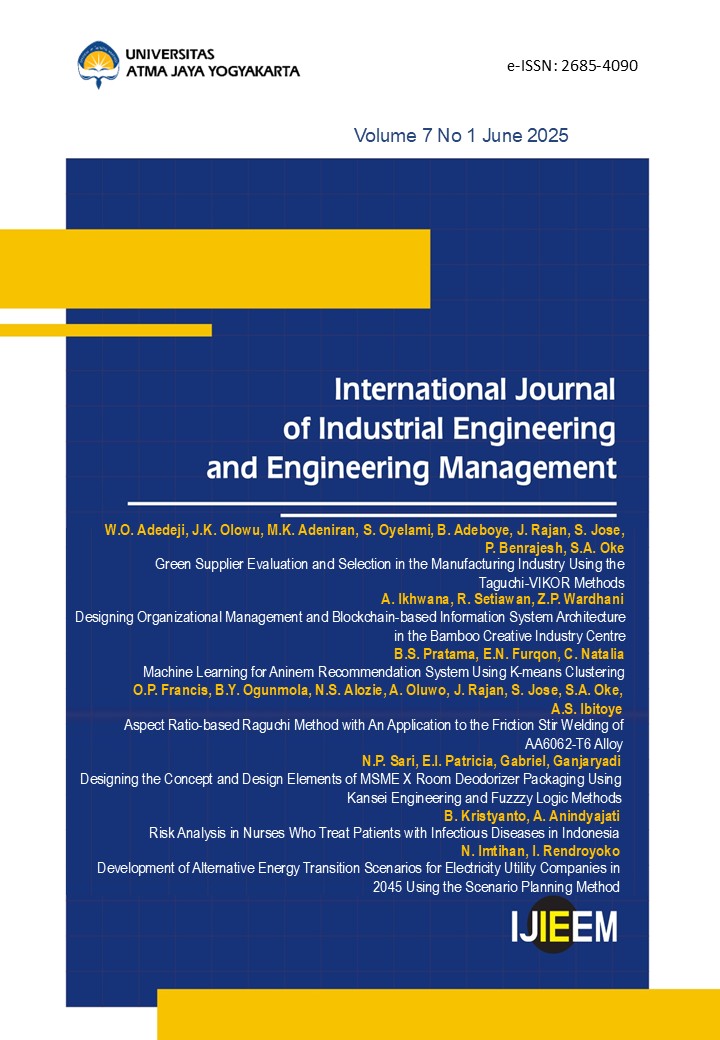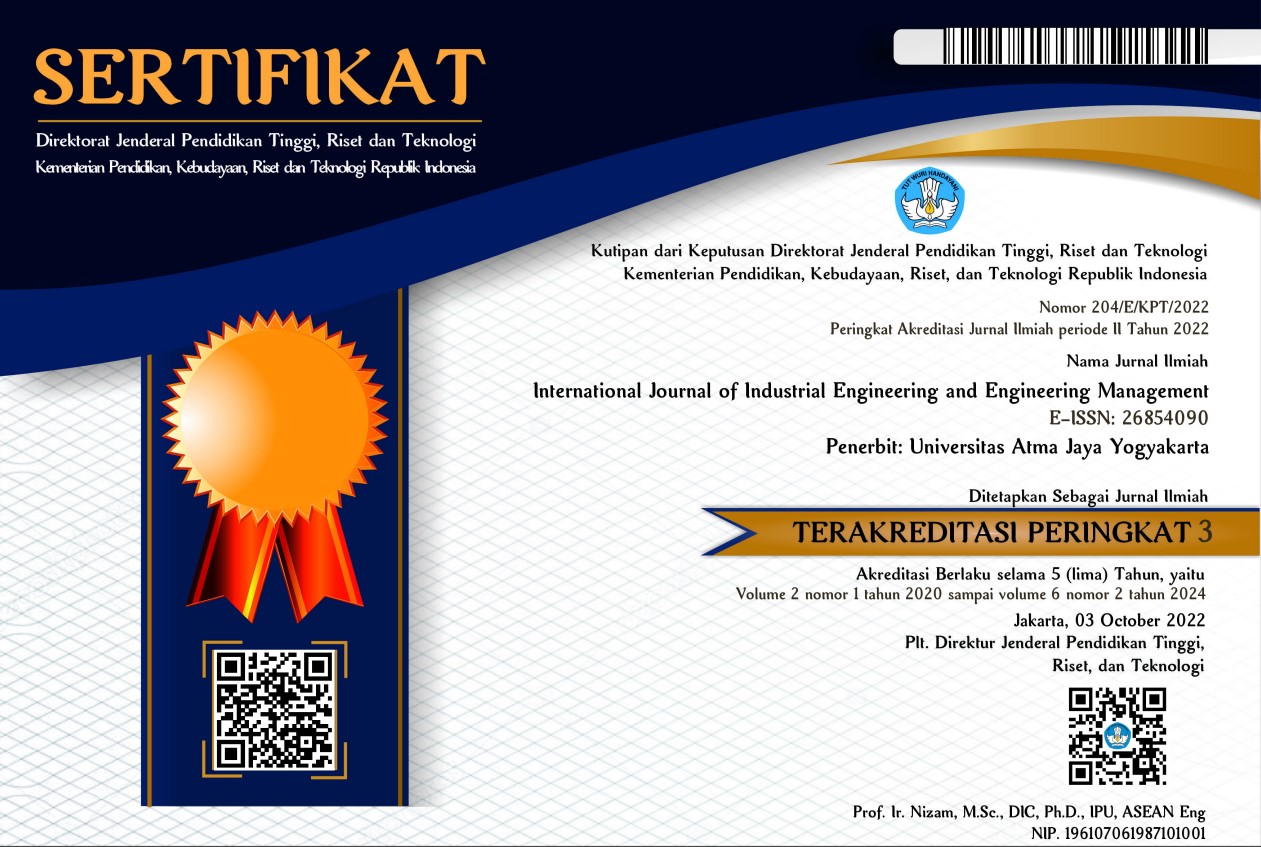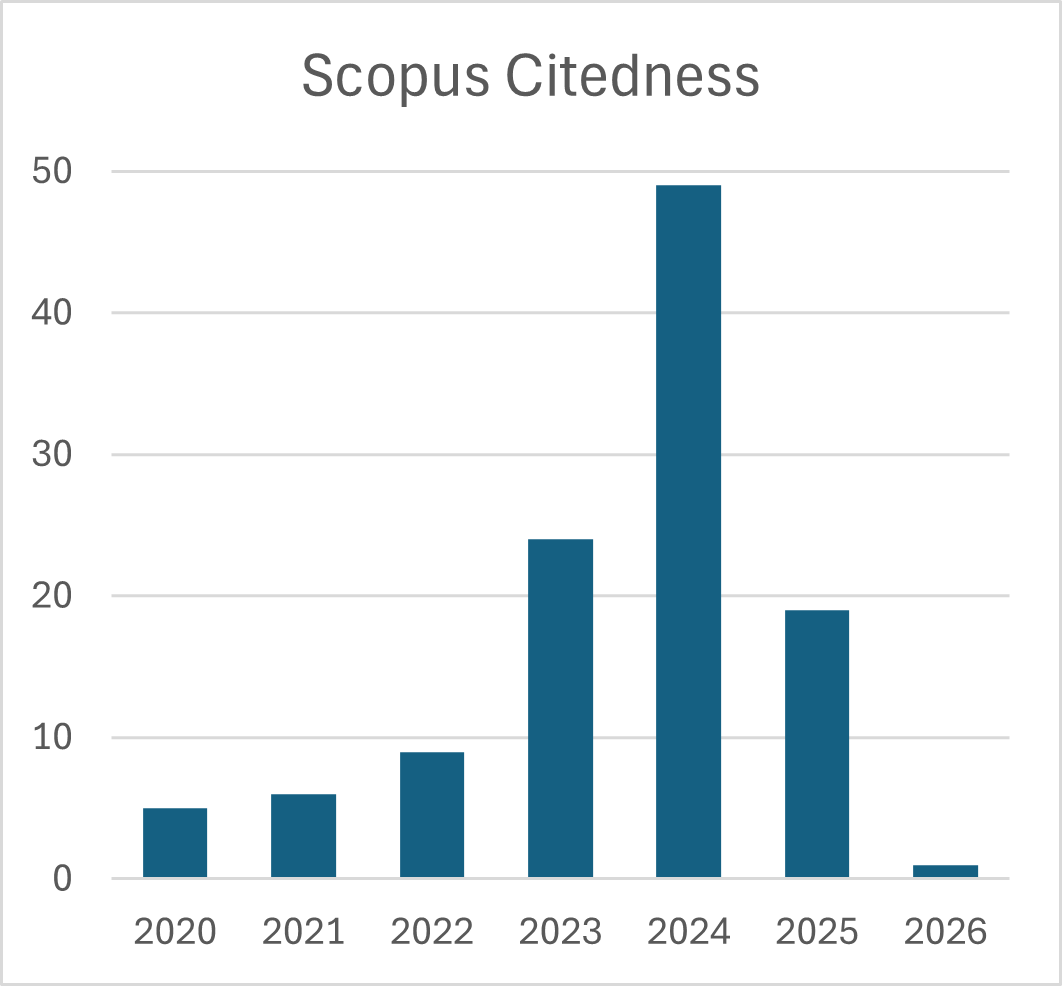Green Supplier Evaluation and Selection in the Manufacturing Industry Using the Taguchi-VIKOR Methods
DOI:
https://doi.org/10.24002/ijieem.v7i1.7778Keywords:
Delta values (estimate of a value), optimization, ranking, selection, emissionAbstract
This paper proposes three methods for the joint optimization and selection of parameters in controlling the exhaust emission from logistics and packing industries, using the Taguchi-VIKOR, Taguchi-Pareto-VIKOR, and Taguchi-ABC-VIKOR methods. From the delta values of the Taguchi method, parameters F, E, A, B, C, and D were placed 1st, 2nd, 3rd, 4th, 5th, and 6th with delta values of 59.0066, 7.5263, 7.5261, 0.1150, 0.1113 and 0.1107, respectively. The delta ratio, delta variability, mean delta value and median delta value are 58.8959, 12.3993, and 3.8206, respectively. Furthermore, the optimal parametric setting is A1B1C1D1E1F1, which means 52 million dollars for revenue, 127 billion packing units, 0.77 optimal growth rate, 1.5 units of materials, 5581 kilotons of quantity consumed and 1 unit of carbon dioxide equivalent of packing materials. The methods are the cornerstone for evaluating the high-performing packing factor associated with greenhouse gas emissions and concurrently obtaining optimized values for packing enterprises to reduce emissions. Besides, and differently from earlier studies, methods such as Pareto, ABC, and VIKOR differentiate the alternative coupled Taguchi methods proposed in the literature. In addition, the following novel elements of the Taguchi method are introduced: Delta ratio, delta variability, mean delta value, delta/HOPV, delta/LOPV, and delta/AOPV. The results suggest that the developed methods adequately represent the optimized values and ranks obtained using the field data set from literature.
References
Akman, G. (2015). Evaluating suppliers to include green supplier development programs via fuzzy c-means and VIKOR methods. Computers & Industrial Engineering, 86, 69-82.
Awasthi, A., & Kannan, G. (2016). Green supplier development program selection using NGT and VIKOR under fuzzy environment. Computers and Industrial Engineering, 91, 100-108.
Bai, C., & Sarkis, J. (2010). Green supplier development: analytical evaluation using rough set theory. Journal of Cleaner Production, 18(12), 1200-1210.
Benrajesh, P., & Rajan, A.J. (2019). Optimizing the exhaust emission from logistics and packing industries, by means of green logistics. Journal of Physics Conference Series, 1355(1), Article 012019.
Bodendorf, F., Dimitrov, G., & Franke, J. (2022). Analyzing and evaluating supplier carbon footprints in supply networks. Journal of Cleaner Production, 372, Article 133601.
Buyukozhan,G., & Cifci, G. (2012). A novel hybrid MCDM approach based on fuzzy DEMATEL, fuzzy ANP, and fuzzy TOPSIS to evaluate green suppliers. Expert Systems with Applications, 39(3), 3000-3011.
Chatterjee, K., Pamucar, D., & Zavadskas, E.K. (2018). Evaluating the performance of suppliers based on using the R'AMATEL-MAIRCA method for green supply chain implementation in electronics industry. Journal of Cleaner Production, 184, 101-129.
Datta, S., Samantra, C., Mahapatra, S.S., Banerjee, S., & Bandyopadhyay, A. (2012). Green supplier evaluation and selection using VIKOR method embedded in fuzzy expert system with interval-valued fuzzy numbers. International Journal of Procurement Management, 5(5), 647-678.
Demir, L., Akpinar, M.E., Araz, C., & Ilgin, M.A. (2018). A green supplier evaluation system based on a new multi-criteria sorting method: VIKORSORT. Expert system with Applications, 114, 479-487.
Dobos, I., & Vorosmarty, G. (2014). Green supplier selection and evaluation using DEA-type composite indicators. International Journal of Production Economics, 157, 273-278.
Dou, Y., Zhu, Q., & Sarkis, J. (2014). Evaluating green supplier development programs with a grey-analytical network process-based methodology. European Journal of Operational Research, 233(2), 420-431.
dos Santos, B.M., Godoy, L.P., & Campos, L.M.S. (2019). Performance evaluation of green suppliers using entropy-TOPSIS-F. Journal of Cleaner Production, 207, 498-509.
Feng, J., & Gong, Z. (2020). Integrated linguistic entropy weight method and multi-objective programming model for supplier selection and order allocation in a circular economy: A case study. Journal of Cleaner Production, 277, Article 122597.
Fu, X., Zhu, Q., & Sarkis, J. (2012). Evaluating green supplier development programs at a telecommunications systems provider. International Journal of Production Economics, 140(1), 357-367.
Gao, H., Ju, Y., Gonzalez, E.D.R.S., & Zhang, W. (2020). Green supplier selection in electronics manufacturing: An approach based on consensus decision making. Journal of Cleaner Production, 245, Article 118781.
Gao, H., Ju, Y., Gonzalez, E.D.R.S., Zeng, X., Dong, P., & Wang, A. (2021). Identifying critical causal criteria of green supplier evaluation using heterogeneous judgments: An integrated approach based on cloud model and DEMATEL. Applied Soft Computing, 113, Article 107882.
Garg, R.K. (2021). Structural equation modeling of E-supplier selection criteria in mechanical manufacturing industries. Journal of Cleaner Production, 311, Article 127597.
Ghadimi, P., Sar, K., & Azadnia, A.H. (2024). An integrated decision-making process for sustainable supplier selection and order allocation in the automotive industry. Procedia CIRP, 122, 1036-1041.
Ghorabaee, M.K., Zavadskas, E.K., Amiri, M., & Esmaeili, A. (2016). Multi-criteria evaluation of green suppliers using an extended WASPAS method with interval type-2 fuzzy sets. Journal of Cleaner Production, 137, 213-229.
Goodarzi, F., Abdollahzade, V., & Zeinalnezhad, M. (2022). An integral multi-criteria decision making and multi-objective optimization framework for green supplier evaluation and optimal order allocation under uncertainty. Decision Analytics Journal, 4(2), Article 100087.
Govindan, K., Rajendran, S., Sarkis, J., & Murugesan, P. (2015). Multi-criteria decision-making approaches for green supplier evaluation and selection: a literature review. Journal of Cleaner Production, 98, 66-83.
Güneri, B., & Deveci, M. (2023). Evaluation of supplier selection in the defense industry using q-rung orthopair fuzzy set based EDAS approach. Expert Systems with Applications, 222, Article 119846.
Hajiaghaei-Keshteli, M., Cenk, Z., Erdebilli, B., Özdemir, Y.S., & Gholian-Jouybari, F. (2023). Pythagorean fuzzy TOPSIS method for green supplier selection in the food industry. Expert Systems with Applications, 224, Article 120036.
Haryono, Masudin, I., Suhandini, Y., & Kannan, D. (2024). Exploring scientific publications for the development of relevant and effective supplier selection methods and criteria in the food Industry: A comprehensive analysis. Cleaner Logistics and Supply Chain, 12, Article 100161.
Jefroudi, M.T., & Darestani S.A. (2024). A decision support system for sustainable supplier selection problem: Evidence from a radiator manufacturing industry. Journal of Engineering Research, 12(4), 867-877.
Kara, K., Acar, A.Z., Polat, M., Önden, İ., & Yalçın, G.C. (2024). Developing a hybrid methodology for green-based supplier selection: Application in the automotive industry. Expert Systems with Applications, 249, Article 123668.
Kumar, S., & Barman, A.G. (2021). Fuzzy TOPSIS and fuzzy VIKOR in selecting green suppliers for sponge iron and steel manufacturing. Soft Computing, 25(8), 6505-6525.
Liou, J.J.H., Chuang, Y., Zavadskas, E.K., & Tzeng, G. (2019). Data-driven hybrid multiple attribute decision-making model for green supplier evaluation and performance improvement. Journal of Cleaner Production, 241, Article 118321.
Liou, J.J.H., Chang, M., Lo, H., & Hsu, M. (2021). Application of an MCDM model with data mining techniques for green supplier evaluation and selection. Applied Soft Computing, 109, Article 107534.
Lo, H., Liou, J.J.H., Wang, H., & Tsai, Y. (2018). An integrated model for solving problems in green supplier selection and order allocation. Journal of Cleaner Production, 190, 339-352.
Lo, H.W. (2023). A data-driven decision support system for sustainable supplier evaluation in the Industry 5.0 era: A case study for medical equipment manufacturing. Advanced Engineering Informatics, 56, Article 101998.
Masoomi, B., Sahebi, I.G., Fathi, M., Yildirim, F., & Ghorbani, S. (2022). Strategic supplier selection for renewable energy supply chain under green capabilities (fuzzy BWM-WASPAS-COPRAS approach). Energy Strategy Reviews, 40, Article 100815.
Mousakhani, S., Nazari-Shirkouhi, S., & Bozorgi-Amiri, A. (2017). A novel interval type-2 fuzzy evaluation model based group decision analysis for green supplier selection problems: A case study of battery industry. Journal of Cleaner Production, 168, 205-218.
Nafei, A., Azizi, S.P., Edalatpanah, S.A., & Huang, C.Y. (2024). Smart TOPSIS: A neural network-driven topsis with neutrosophic triplets for green supplier selection in sustainable manufacturing. Expert Systems with Applications, 255, Article 124744.
Norheim-Hansen, A. (2023). Green supplier development: What’s in it for you, the buyer? Business Horizons, 66(1), 101-107.
Rahman, M.M., Bari, A.B.M.M., Ali, S.M., & Taghipour, A. (2022). Sustainable supplier selection in the textile dyeing industry: An integrated multi-criteria decision analytics approach. Resources, Conservation & Recycling Advances, 15, Article 200117.
Pérez-Velázquez, A., Oro-Carralero, L.L., & Moya-Rodrí, J.L. (2020). Supplier selection for photovoltaic module installation utilizing fuzzy inference and the VIKOR method: A green approach. Sustainability (Switzerland), 12(6), Article 2242.
Sarkar, S., Modak, N.M., Giri, B.C., Sarkar, A.K., & Cardenas-Barron, L.E. (2022). Coordinating a supplier–retailer JELS model considering product quality assessment and green retailing. Journal of Cleaner Production, 356, Article 131658.
Sharafi, H., Soltanifar, M., & Lotfi, F.H. (2022). Selecting a green supplier utilizing the new fuzzy voting model and the fuzzy combinative distance-based assessment method. EURO Journal on Decision Processes, 10, Article 100010.
Shen, L., Olfat, L., Govindan, K., Khodaverdi, R., & Diabat, A. (2013). A fuzzy multi-criteria approach for evaluating green supplier's performance in green supply chain with linguistic preferences. Resources, Conversation and Recycling, 74, 170-179.
Singh, R.R., Zindani, D., & Maity, S.R. (2024). A novel fuzzy-prospect theory approach for hydrogen fuel cell component supplier selection for the automotive industry. Expert Systems with Applications, 246, Article 123142.
Sonar, H., Gunasekaran, A., Agrawal, S., & Roy, M. (2022). Role of lean, agile, resilient, green, and sustainable paradigm in supplier selection. Cleaner Logistics and Supply Chain, 4, Article 100059.
Wu, Q., Zhou, L., Chen, Y., & Chen, H. (2019). An integrated approach to green supplier selection based on the interval type-2 fuzzy best-worst and extended VIKOR methods. Information Sciences, 502, 394 – 417.
Wu, X., & Liao, H. (2023). Geometric linguistic scale and its application in multi-attribute decision-making for green agricultural product supplier selection. Fuzzy Sets and Systems, 458, 182-200.
Yang, Y., & Jiang, Y. (2023). Does suppliers’ slack influence the relationship between buyers’ environmental, orientation and green innovation? Journal of Cleaner Production, 157, Article 113569.
Zhang, F., Li, Y., Li, F., Yuan, J., & Li, Y. (2022). Decision-making behaviour of power suppliers in the green certificate market: A system dynamics analysis. Energy Policy, 171, Article 113296.
Downloads
Published
How to Cite
Issue
Section
License
Copyright (c) 2025 WOA, JKO, MKA, SO, BA, JR, Swaminathan Jose, Pandiaraj Benrajesh, Sunday Ayoola Oke

This work is licensed under a Creative Commons Attribution 4.0 International License.








